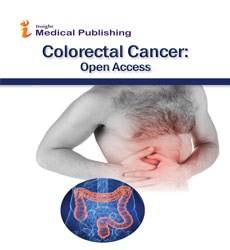The Endoscopic Treatment
Zhou Zemin*
Department of Oncology, Peking University, Beijing, China
- *Corresponding Author:
- Zhou Zemin
Department of Oncology,
Peking University,
Beijing,
China;
E-mail: Vasquez213@gmail.com
Received date: November 17, 2022, Manuscript No. IPJCC-22-14888; Editor assigned date: November 21, 2022, PreQC No. IPJCC-22-14888 (PQ); Reviewed date: December 06, 2022, QC No. IPJCC-22-14888; Revised date: January 20, 2023, Manuscript No. IPJCC-22-14888 (R); Published date January 27, 2023, DOI: 10.36648/2471-9943.9.1.001
Citation: Zemin Z (2023) The Endoscopic Treatment. Colorec Cancer Vol:9 No:1
Introduction
Colorectal surgery is performed for many diseases such as colorectal cancer, ulcerative colitis, Crohn’s disease, mechanical bowel obstruction and recurrent diverticulitis, often resulting in major reconstruction of the gastrointestinal tract. Injury, ischemia, rectal prolapse and proctological disorders may also require large or small bowel resection. Potential risks of colorectal surgery are mainly those of any major abdominal surgery, and usually occur while the patient is still in the hospital. Because of the many indications for and the various extents of colorectal or small bowel resections the rate and spectrum of complications differ.
A literature search was carried out, using MEDLINE, PubMed and the Cochrane library from 1980 to 2009 using the following terms: Complications, risk factors, colorectal surgery, colorectal resection, laparoscopy, surgical site infection, anastomotic leakage, and bowel cleansing. This review is a general overview that provides an update on these topics for the reader.
Risk factors in emergency, in elective open and laparoscopic colorectal surgery should be recognized prior to surgery in order to reduce complications and to initialize individualized treatment as soon as possible. However, some risk factors such as age, gender and prior abdominal surgery can obviously not be influenced before surgery.
Description
In general, complications can be divided into intraoperative and postoperative complications. Occurrence of intraoperative complications such as bleeding, bowel injury, ureteral lesions and bladder injuries are caused by intra abdominal adhesions, anatomic problems, the experience of the surgeon and many other factors. Major postoperative complications include wound infection, anastomotic leakage, ileus and bleeding. Only a few recent publications elucidate risk factors for intra and postoperative complications in colorectal surgery. The importance of some risk factors such as age, nutrition status of the patient and experience of the surgeon are becoming more accepted. In addition, there are many other factors that influence outcome of colorectal surgery which could be modified preoperatively.
Therapeutic endoscopy is the medical term for an endoscopic procedure during which treatment is carried out via the endoscope. This contrasts with diagnostic endoscopy, where the aim of the procedure is purely to visualize a part of the gastrointestinal, respiratory or urinary tract in order to aid diagnosis. In practice, a procedure which starts as a diagnostic endoscopy may become a therapeutic endoscopy depending on the findings, such as in cases of upper gastrointestinal bleeding, or the finding of polyps during colonoscopy.
A number of different techniques have been developed to allow treatment to be carried out endoscopically, to treat disorders such as bleeding, strictures and polyps.
Endoscopic injection of bleeding peptic ulcers with adrenaline has been practiced since the 1970’s, endoscopic heater probes have been used since the 1980s and Argon plasma coagulation has been used since the 1990s. More recently, adrenaline injection tends to be combined with either heater probe coagulation or argon plasma coagulation to minimize the chance of an ulcer rebleeding. The disadvantage of this treatment is a low risk of perforation of the gastric wall and a low risk of peritonitis. Combined therapy may work better than epinephrine alone. However, there is no evidence that one kind of treatment is more effective than the other.
Dilatation of benign esophageal strictures using semi-rigid bougies existed long before the advent of flexible endoscopes. Since that time esophageal dilatation has been carried out using either bougies or endoscopic balloons, and can be used to treat benign esophageal strictures and achalasia.
Initially, bougies were used to dilate benign strictures of the oesophagus. These could be passed alongside the endoscope, allowing visualisation of the bougie passing through the stricture, but the technique of passing a guidewire through the stricture endoscopically, then removing the endoscope and passing the bougie over the guide wire was more commonly used.
More recently, balloon dilatation of the esophageal structures has become more common. It is thought that this technique carries a lower complication rate than the use of bougies, and since endoscopy balloons are single use items there are no concerns about equipment sterilization. In addition to esophageal dilatation, endoscopic balloons can also be used to dilate pyloric strictures.
Conclusion
Argon Plasma Coagulation (APC) has been used to provide tissue coagulation and haemostasis since the early part of the 1990’s. A stream of argon gas is passed through an endoscopic catheter; this is then ionized at the tip of the catheter by an electric current. The tip of the catheter is held close to the tissue to be treated, and the current arcs across to the tissue causing a superficial (2 mm–3 mm) burn. The lack of contact between the catheter and the tissue stops the tendency of the catheter to stick to the tissue, reducing unwanted tissue damage.
Its principal use is in providing haemostasis in gastrointestinal bleeding; angiodysplasia gave, bleeding malignant tumours and bleeding peptic ulcers can all be treated. Trials have also been carried out to assess its use in eradicating Barrett’s oesophagus, but have found that relapse is common.
Open Access Journals
- Aquaculture & Veterinary Science
- Chemistry & Chemical Sciences
- Clinical Sciences
- Engineering
- General Science
- Genetics & Molecular Biology
- Health Care & Nursing
- Immunology & Microbiology
- Materials Science
- Mathematics & Physics
- Medical Sciences
- Neurology & Psychiatry
- Oncology & Cancer Science
- Pharmaceutical Sciences
